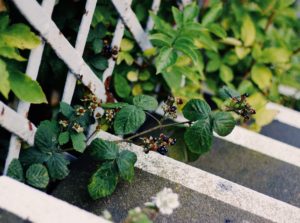Blackberry/Rubus Spp.
What is it? Blackberries are a thorny vine in the Raspberry family. They tend to grow in large patches, creating a hedge of protection for any wild creature who dares venture in. The blackberry provides much food in ways people may have never dreamed of, so today we will go over the basics, and the complicated.
Where to find it? Blackberries can be found growing almost all over America, although they will be identified as different varieties. They’ve grown in fields, stream banks, roadsides, and any possible place where there is extra space, water, and enough sunlight. But if there are none near you, try looking into a local blackberry picking farm as they will probably have thorn-less berries to enjoy without suffering from scratches.
What to eat? Obviously, the berries can be eaten. Pick them when they have turned a dark purple, or black, color. An easy sign that they are ready is when they roll off of the stem easily onto your hand. But, there are other things you can do with the Blackberry that most people didn’t know about. The leaves and flowers are used to make the best forager’s teas, although it’s recommended you don’t use the flowers as that would result in less fruit. The root can also be eaten to everyone’s surprise! Unfortunately, it requires a lot of boiling, and needs to be in the perfect stage: neither to young nor old. Lastly, the young shoots of a sprouting blackberry can be harvested, peeled, and then eaten like a normal vegetable.
When to find it? You can find blackberries all year long, even during the winter; however it is useless in the winter without its leaves, young shoots, flowers, or berries. In the spring time, its white flowers come out, and during the summer, the berries form and turn white, red, and black colors. The leaves stay green almost all year long, and eventually fall to the ground in fall.
What does it look like? The blackberry is a shrubby and quite thorny vine that grows in large patches near any source of water. So if Blackberries are growing, then water should be flowing near-by. The leaves grow in compounds of five; they are ovate, dark green when older, and heavily teethed. Most of the older leaves also have painful thorns on the underside of the leaf, so be careful when harvesting. During the late summer, the berries turn from green, to white, to red, then finally black. The flowers have five petals, and are usually a white color, but every now and then they might have a pinkish hue.
How to enjoy it? You can make jams, wines, juices, pies, breads, jellies, and so much more with the berries. The young leaves, after being dried, make the very best tea. And when you make the tea, be sure to cover the cup so the rich flavors do wafer around into your kitchen and leave the cup. The flowers also make good tea, but it’s best to keep those for the berries. And the root has been reported to be edible; it just takes a long process of boiling to make it edible and tasty. Do your own research to be safe. And finally, the young shoots of a sprouting blackberry can be harvested, peeled, and eaten like a fresh vegetable in a salad.
Medicinal Properties? Interestingly, there are many medicinal properties to the blackberries’ fruit, and unfortunately, people don’t realize it as the blackberry is not a delicious fruit that is regularly on sale at the supermarket. They have significant amounts of vitamin C, vitamin K, plenty of dietary fiber, and several other nutrients. What are even more amazing are the seeds the blackberry has inside the fruit. The seeds have been found to be rich in protein, dietary fibers, omega-3, carotenoids, ellagitannins, and ellagic acid. These interesting nutrients are some of the things people use today to help fight diseases like heart disease, and cancer.








